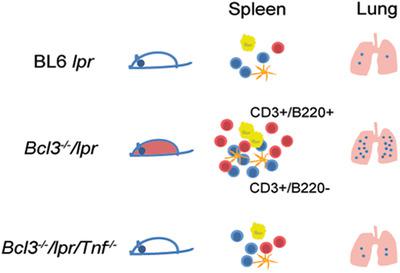当前位置:
X-MOL 学术
›
Eur. J. Immunol.
›
论文详情
Our official English website, www.x-mol.net, welcomes your
feedback! (Note: you will need to create a separate account there.)
Bcl-3 inhibits lupus-like phenotypes in BL6/lpr mice.
European Journal of Immunology ( IF 4.5 ) Pub Date : 2020-07-11 , DOI: 10.1002/eji.202048584 Wanhu Tang 1 , Hongshan Wang 1 , Ruxiao Tian 1 , Sun Saret 1 , HeeJin Cheon 1 , Estefania Claudio 1 , Ulrich Siebenlist 1
European Journal of Immunology ( IF 4.5 ) Pub Date : 2020-07-11 , DOI: 10.1002/eji.202048584 Wanhu Tang 1 , Hongshan Wang 1 , Ruxiao Tian 1 , Sun Saret 1 , HeeJin Cheon 1 , Estefania Claudio 1 , Ulrich Siebenlist 1
Affiliation

|
Bcl‐3 is an atypical member of the IκB family that modulates NF‐κB activity in nuclei. lpr mice carry the lpr mutation in Fas, resulting in functional loss of this death receptor; they serve as models for lupus erythematosus and autoimmune lymphoproliferation syndrome (ALPS). To explore the biologic roles of Bcl‐3 in this disease model, we generated BL6/lpr mice lacking Bcl‐3. Unlike lpr mice on an MRL background, BL6/lpr mice present with very mild lupus‐ or ALPS‐like phenotypes. Bcl‐3 KO BL6/lpr mice, however, developed severe splenomegaly, dramatically increased numbers of double negative T cells — a hallmark of human lupus, ALPS, and MRL/lpr mice — and exhibited inflammation in multiple organs, despite low levels of autoantibodies, similar to those in BL6/lpr mice. Loss of Bcl‐3 specifically in T cells exacerbated select lupus‐like phenotypes, specifically organ infiltration. Mechanistically, elevated levels of Tnfα in Bcl‐3 KO BL6/lpr mice may promote lupus‐like phenotypes, since loss of Tnfα in these mice reversed the pathology due to loss of Bcl‐3. Contrary to the inhibitory functions of Bcl‐3 revealed here, this regulator has also been shown to promote inflammation in different settings. Our findings highlight the profound, yet highly context‐dependent roles of Bcl‐3 in the development of inflammation‐associated pathology.
中文翻译:

Bcl-3抑制BL6 / lpr小鼠中的狼疮样表型。
Bcl-3是IκB家族的非典型成员,可调节细胞核中的NF-κB活性。lpr小鼠在Fas中携带lpr突变,导致该死亡受体功能丧失;它们可作为红斑狼疮和自身免疫性淋巴增殖综合征(ALPS)的模型。为了探索Bcl-3在这种疾病模型中的生物学作用,我们生成了缺少Bcl-3的BL6 / lpr小鼠。与具有MRL背景的lpr小鼠不同,BL6 / lpr小鼠表现出非常轻度的狼疮或ALPS样表型。但是,Bcl-3 KO BL6 / lpr小鼠发展为严重的脾肿大,双阴性T细胞数量急剧增加,这是人类狼疮,ALPS和MRL / lpr的标志小鼠,尽管自身抗体水平较低,但在多个器官中仍表现出炎症,类似于BL6 / lpr小鼠。Bcl-3在T细胞中的丢失特别加剧了某些狼疮样表型,尤其是器官浸润。从机理上讲,Bcl-3 KO BL6 / lpr小鼠中Tnfα的水平升高可能促进狼疮样表型,因为这些小鼠中Tnfα的丧失会由于Bcl-3的丧失而逆转病理。与此处揭示的Bcl-3抑制功能相反,该调节剂还被证明可以在不同环境中促进炎症。我们的发现突出了Bcl-3在炎症相关病理学发展中的深远但高度依赖于上下文的作用。
更新日期:2020-07-11
中文翻译:

Bcl-3抑制BL6 / lpr小鼠中的狼疮样表型。
Bcl-3是IκB家族的非典型成员,可调节细胞核中的NF-κB活性。lpr小鼠在Fas中携带lpr突变,导致该死亡受体功能丧失;它们可作为红斑狼疮和自身免疫性淋巴增殖综合征(ALPS)的模型。为了探索Bcl-3在这种疾病模型中的生物学作用,我们生成了缺少Bcl-3的BL6 / lpr小鼠。与具有MRL背景的lpr小鼠不同,BL6 / lpr小鼠表现出非常轻度的狼疮或ALPS样表型。但是,Bcl-3 KO BL6 / lpr小鼠发展为严重的脾肿大,双阴性T细胞数量急剧增加,这是人类狼疮,ALPS和MRL / lpr的标志小鼠,尽管自身抗体水平较低,但在多个器官中仍表现出炎症,类似于BL6 / lpr小鼠。Bcl-3在T细胞中的丢失特别加剧了某些狼疮样表型,尤其是器官浸润。从机理上讲,Bcl-3 KO BL6 / lpr小鼠中Tnfα的水平升高可能促进狼疮样表型,因为这些小鼠中Tnfα的丧失会由于Bcl-3的丧失而逆转病理。与此处揭示的Bcl-3抑制功能相反,该调节剂还被证明可以在不同环境中促进炎症。我们的发现突出了Bcl-3在炎症相关病理学发展中的深远但高度依赖于上下文的作用。









































 京公网安备 11010802027423号
京公网安备 11010802027423号